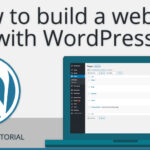WordPress is a widely-used content management system (CMS) that enables users to create and manage websites, ranging from simple blogs to complex e-commerce sites and corporate portals. Initially released in 2003 as a blogging platform, WordPress has since evolved into a versatile and powerful tool for building and customizing websites without requiring extensive technical knowledge.
Key features of WordPress include:
- User-friendly interface: WordPress offers an intuitive dashboard and editor that make it easy for users to create, edit, and publish content without needing to write code.
- Customization: With thousands of themes and plugins available, users can customize the appearance and functionality of their websites to suit their specific needs and preferences.
- Scalability: WordPress can scale from small personal blogs to large enterprise websites, making it suitable for a wide range of users and organizations.
- Community support: WordPress has a large and active community of developers, designers, and users who contribute to its development, provide support, and create resources such as themes, plugins, and tutorials.
- Open-source: WordPress is open-source software, meaning it is free to use, modify, and distribute. This openness fosters innovation and ensures that WordPress remains accessible to users of all backgrounds.
Overall, WordPress is a flexible and powerful platform that empowers individuals and businesses to create professional-looking websites with ease. Its combination of user-friendly features, customization options, and community support has made it one of the most popular CMS platforms in the world.
WordPress is a versatile and widely-used content management system (CMS) that powers millions of websites across the internet. Initially launched in 2003 as a blogging platform, WordPress has evolved into a comprehensive CMS that allows users to create, manage, and customize various types of websites, from blogs and personal portfolios to e-commerce stores and corporate websites.
At its core, WordPress offers a user-friendly interface for managing website content, allowing users to create and publish pages, blog posts, images, videos, and other media with ease. Its intuitive editor enables both beginners and experienced users to format and style content without needing to write code.
One of the key strengths of WordPress is its flexibility and extensibility. With thousands of themes and plugins available, users can customize their websites to meet their specific design and functionality requirements. Themes control the visual appearance of a WordPress site, while plugins add additional features and functionality, such as e-commerce capabilities, SEO optimization, contact forms, and social media integration.
WordPress also boasts a vibrant community of developers, designers, and users who contribute to its ecosystem by creating themes, plugins, tutorials, and support resources. This community-driven approach has helped WordPress become the go-to choice for individuals, businesses, and organizations seeking a powerful, scalable, and cost-effective solution for building and managing their online presence.
Furthermore, WordPress is open-source software, which means it is free to use and can be modified and redistributed by anyone. This openness fosters innovation and collaboration while ensuring that WordPress remains accessible to users of all backgrounds and budgets.
In summary, WordPress is a robust and customizable CMS that empowers users to create professional-looking websites and manage content with ease. Whether you’re a blogger, entrepreneur, freelancer, or large enterprise, WordPress provides the tools and resources needed to bring your online vision to life.
Here are 20 tips for getting the most out of WordPress:
- Choose a Reliable Hosting Provider: Select a hosting provider that offers good performance, security, and support tailored to WordPress websites.
- Keep WordPress Updated: Regularly update WordPress core, themes, and plugins to ensure your site remains secure and optimized.
- Use a Responsive Theme: Opt for a responsive theme that adapts to different screen sizes, ensuring a seamless experience for users on mobile devices.
- Optimize Permalinks: Customize your permalink structure to include keywords and make URLs more SEO-friendly.
- Install Essential Plugins: Install essential plugins for functions such as SEO optimization, security, backups, and caching to enhance your site’s performance and functionality.
- Backup Your Site Regularly: Set up regular backups of your WordPress site to protect against data loss and security threats.
- Optimize Images: Compress and optimize images to improve site speed and performance without sacrificing quality.
- Enable Caching: Use a caching plugin to improve page load times and reduce server load by storing static versions of your site’s pages.
- Utilize Categories and Tags: Organize your content with categories and tags to improve navigation and SEO.
- Create SEO-friendly Content: Write high-quality, keyword-rich content that is optimized for search engines to improve your site’s visibility and rankings.
- Implement Security Measures: Strengthen your site’s security by using strong passwords, enabling two-factor authentication, and limiting login attempts.
- Optimize for Speed: Minimize page load times by optimizing code, reducing server requests, and leveraging browser caching.
- Add Contact Forms: Use a plugin to create contact forms that make it easy for visitors to get in touch with you.
- Enable Comments Moderation: Moderate comments to prevent spam and ensure a positive user experience for your site’s visitors.
- Create a Custom 404 Page: Design a custom 404 error page to help users navigate your site when they encounter broken links or missing content.
- Utilize Widgets: Add widgets to your site’s sidebar or footer to display additional content, such as social media feeds, recent posts, or newsletter sign-up forms.
- Optimize for Social Sharing: Include social sharing buttons on your site to encourage visitors to share your content on social media platforms.
- Monitor Site Analytics: Use tools like Google Analytics to track site traffic, user behavior, and engagement metrics to identify areas for improvement.
- Enable SSL: Secure your site by enabling SSL (Secure Sockets Layer) to encrypt data transmitted between your site and visitors’ browsers.
- Regularly Review and Update Content: Keep your site fresh and relevant by regularly reviewing and updating content, removing outdated information, and adding new content to keep visitors engaged.
Implementing these tips will help you optimize your WordPress site for performance, security, and user experience, ultimately helping you achieve your website goals more effectively.





